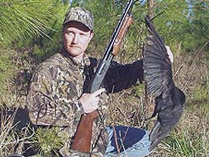
I flipped the switch on the electronic crow caller and began playing a cassette tape labeled "Fighting Crows". From the speaker came the loud cawing sounds of dozens of crows stirred into a frenzy by some unidentifiable enemy.
 |
| FOXPRO Super Snow Crow Pro Electronic Game Call System |
A flock of crows, like a street gang, is always ready to rumble. These birds love a group fight with an enemy, whether it be an owl, hawk, fox or house cat, and when an enemy is spotted, the crows gather round and begin cawing loudly. These fighting sounds draw in scores of crows and keep them so fired up they'll ignore all dangers around them, even hunters. I was counting on this behavior when I turned on the caller.
I had joined my friends Joe and David for an Arkansas crow hunt. Before turning on the caller, the three of us, dressed in camouflage clothing, had concealed ourselves in dense undergrowth on a woodland edge. We were positioned 20 yards apart, with a good view of the surrounding countryside that would allow us to see crows flying in. We scattered a few full-body crow decoys in the corn field around us, and a great horned owl decoy was strategically placed in a tree above us. Crows hate owls. If they saw this lifelike replica when they approached, they'd move in close and focus their attention on it instead of us.
 What surprised me most was the quickness of the crows' reaction. We heard a few crows in the distance as we set up to hunt, but none were visible. But when the sounds of fighting began, there was an immediate response. Nearly half a mile away, I saw a crow leave the woods and begin flying our way, then another and another and another. Within minutes, the trees around us were swarming with cawing crows.
What surprised me most was the quickness of the crows' reaction. We heard a few crows in the distance as we set up to hunt, but none were visible. But when the sounds of fighting began, there was an immediate response. Nearly half a mile away, I saw a crow leave the woods and begin flying our way, then another and another and another. Within minutes, the trees around us were swarming with cawing crows.
We waited until several crows were within shotgun range, then, as we had previously agreed, I fired the first shot, the signal to "Take them!"
 I dropped one crow then another, as did David and Joe. The crows were so intent on harassing the owl, the first shot didn't frighten them away. Several continued their noisemaking, and those met their maker as well. Before the crows wised up, we had killed a dozen, and I found myself hooked on crow hunting.
I dropped one crow then another, as did David and Joe. The crows were so intent on harassing the owl, the first shot didn't frighten them away. Several continued their noisemaking, and those met their maker as well. Before the crows wised up, we had killed a dozen, and I found myself hooked on crow hunting.
Man has never had much of a love affair with crows. These large black birds are beneficial consumers of harmful insects, and important scavengers, helping clean up roadkills, dead fish and other carrion.
Unfortunately, crows also are destructive to crops like pecans and corn. And because they hunt for eggs and nestlings, in areas where they are especially numerous they may seriously impact populations of gamebirds, songbirds and herons, making it necessary to control their numbers. Hunting them offers a means of control and a first-rate challenge for sportsmen.
The American crow is the most commonly hunted species. These handsome black birds live in woodlands and urban areas but seem especially fond of large, open farm-country fields. They form flocks of 25 to 50 birds in autumn and winter.
 |
| Hunter's Specialties H.S. Strut Pro Line Crow Caller |
Some hunters learn daily flight patterns as crows travel between roosts and feeding areas, then set up beneath flight paths to take their quarry. Others drive through the countryside searching for small bands of feeding or calling crows. A quick blind then is constructed, or the hunter conceals himself in some other manner. Then the calling begins.
Electronic and hand crow callers like the popular Hunter's Specialties H.S. Strut Pro Line Crow Caller both are used. Each has a place in crow calling, and their use often overlaps.
Hand callers are inexpensive, easily carried and easily mastered. Picking from the many models is a personal choice, but avoid "windy" callers that require lots of air to blow. Crow hunting requires extended calling with high volume. A windy caller will wear you out. Also, look for callers with a movable, rather than fixed reed. This allows tuning to produce sounds from the high falsetto of young birds to the guttural rasps of old-timers.
Electronic callers can produce the sounds of multiple crows simultaneously. Your hands aren't busy when shooting time comes because the caller can be turned on and left alone. The sounds played are the ultimate in realism. Novice hunters can experience fun results immediately with these units.
If you use a hand caller, practice variations of the two basic call types — friendly and fighting. Each has subtle variations that make it effective for a particular setup or situation. Having a veteran caller teach you is the best way to learn, but instructional videotapes and audio cassettes also are available.
Using an electronic caller is easy. Carry fresh batteries and you can call crows continuously for hours.
Decoys focus a crow's attention away from the hunter. Two types — silhouette and full-body — frequently are used, often together.
 |
| RedHead Owl Decoy sold at Bass Pro Shops |
If you intend to set up a "crow versus owl" scene, you'll also need an owl decoy like the RedHead Owl Decoy sold at Bass Pro Shops. Most resemble the great horned owl. Some are made full-body style in hard plastic, others in cardboard silhouettes with photo-realistic owl imprints.
Friendly and fighting decoy setups are commonly used. The friendly setup mimics a group of foraging crows and should be placed where crows might normally feed such as a field, orchard or dump. Place a few decoys high in tree branches to give your setup long-range visual appeal and to simulate the crows' natural habit of posting sentries. Feeding decoys on the ground should be randomly spaced about 30-35 yards from your stand. Most hunters use as many decoys as possible to simulate a large feeding group.
The fighting setup simulates a crow-owl conflict. An artificial owl is positioned on a fence post, the top of a small tree or a long pole, so every crow nearby can spot it. Unlike the friendly setup, position most decoys above the ground in surrounding trees and brush. In a real fight, crows usually sit in surrounding trees to scold the owl.
When you begin hunting, avoid these common mistakes:
- Over-hunting an area. Crows are smart; they remember. It may be tempting to constantly revisit an area where you had a great shoot, but if done too often, the birds get call-shy. Scout several good areas, then "leapfrog" from one to another to avoid problems.
- Not being properly camouflaged. Crows easily detect colors, shapes and silhouettes that are out of place. Wear complete camouflage — body, head and hand — that matches your surroundings.
- Premature cessation of calling. Some hunters cease calling as soon as shots are fired, thinking the crows will leave as soon as shooting begins. Though this is sometimes the case, crows sometimes get so worked up, they'll return to the decoys again and again if you keep up a steady stream of calls, even during gunfire.
- Calling with too much volume. Some electronic calls can be cranked up to produce a tremendous call volume when needed. This can be helpful when trying to get the attention of distant crows, but too much volume can be detrimental when birds approach. Reduce the volume to a "normal" level as the crows move in your direction.
- Leading birds too far. Crows typically move slower than other gamebirds, and many first-time shooters tend to lead them too far when shooting. Normally find your target with a beak-length lead after the crows enter the decoy zone.
- Not carrying a spare caller or batteries. Calling with a hand caller requires lots of blowing and usually a lot of spit. This causes reeds to stick or freeze up, especially during periods of extreme cold. Always have a spare caller hanging around your neck in case of a failure. Carry spare batteries and a spare calling tape for electronic callers.
The more you learn about the various nuances of crow hunting, the better hunter you'll become. But even beginners can be successful at pursuing these abundant black rascals. Only a few basic items of equipment are necessary, and none are hard to use. The sport is challenging and simple at the same time, and will help hone your calling and shooting skills.
Best of all, crows are abundant and huntable throughout much of the U.S. Once you've tried crow hunting, you'll be glad of that. Because once you're hooked, like me, you'll want to go crow hunting as often as you can.
- 8219 views

